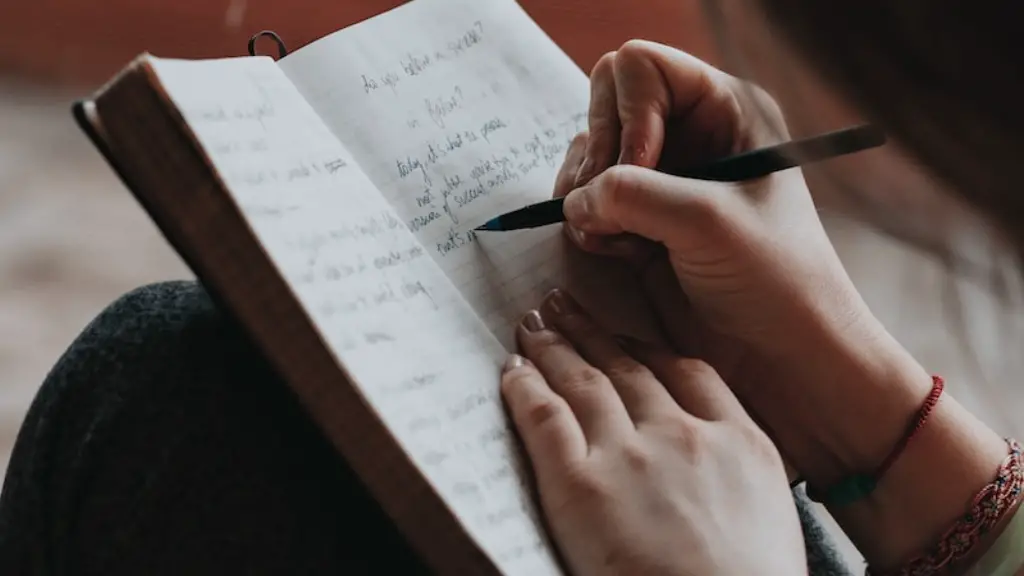What is Kenning in Poetry?
Kenning is an Anglo-Saxon type of figurative language used to describe an object in place of its name. Kenning has been popular in the English language since the Anglo-Saxon period, and has been used in various forms of literature, including poetry. As a form of metaphor, kennings provide writers with the ability to explore abstractions and create poetic imagery.
A kenning usually involves a compound expression made up of two or more words strung together to form a phrase. For example, instead of saying ‘king’, a kenning might say ‘ring-gatherer’. Additionally, kennings can be used to describe an object by comparing it to another object, as in: ‘heart-fire’, instead of ‘passion’. The purpose of the kenning is to make the written work impactful and to allow the reader to gain a better understanding by providing certain visuals within the work.
A well-known example of a kenning is ‘whale-road’, which refers to the ocean. This example is quite powerful because it conveys the vastness of the ocean and alludes to the metaphor of the ocean being a journey, signified by ‘road’. As a result, it creates a more interesting and meaningful image of the ocean depth, which in turn can be applied to the poem.
Kennings are also used in modern poetry, but are not as common as they used to be. They are still an effective way to create more interesting and evocative images, so many poets continue to use them today. However, kennings can be difficult to use appropriately and some poets find them to be too cliche and overused. Despite these drawbacks, kennings can add a deeper level of meaning and emotion to a poem.
A kenning can evoke awe, mystery, and emotion in the reader. It forces the reader to pause and consider the power of the image and the metaphor and to contemplate how it can be applied to the overall story being told in the poem. This type of figurative language can enable the reader to explore esoteric ideas in a creative way, and can make a poem even more memorable.
Definition of a Kenning
A kenning is a compound of two or more words used to stand for an object, action, or idea. The purpose of this figurative language is to create a more vivid image of the object or idea and to provide a more interesting way to describe it. It can also be used to allude to a certain emotion or to convey a certain message in the poem.
The words used in a kenning can be literal or metaphorical. For example, the phrase ‘ring-gatherer’ could describe a king, or it could be a metaphor for someone who acquires or accumulates wealth. This type of figurative language can provide greater depth to the story and make the poem more engaging.
Kennings can be found in many different types of literature, including sagas and epic poems. For example, in Norse sagas, kennings are often used to refer to different characters, creatures, and actions. In Anglo-Saxon poems, kennings are used to refer to different elements of nature or mythical creatures.
Examples of Kennings
There are countless examples of kennings in literature. Some common examples include:
- ‘Gift-seat’ for a throne
- ‘Sail-road’ for the sea
- ‘Harvest-blade’ for a plow
- ‘Silent-hoverer’ for an owl
- ‘Whetstone’s edge’ for a sword
Many of these examples refer to objects or creatures in a creative, figurative way. For instance, ‘sail-road’ brings to mind imagery of ships on the sea, while ‘whetstone’s edge’ implies that the sword is as sharp as a stone meant to sharpen other objects. This type of figurative language can provide a more vivid and captivating description of the object or creature in question.
Why Use Kennings in Poetry?
Kennings are often used in poetry to provide a more interesting and vivid description of an object or idea. This can help to convey a certain emotion or to emphasize a certain message. It can also make a poem more meaningful, as it can provide the reader with a more emotional connection to the words on the page.
Kennings can also be used to allude to certain metaphors or motifs. For example, the phrase ‘ring-gatherer’ could be used to refer to a ruler and their power and to emphasize the idea of accumulation or gathering. By using a kenning, the reader is encouraged to consider the implications of the metaphor or motif and to make a deeper connection to the poem.
In addition, kennings can be used to create a sense of mystery or wonder. By using figurative language, the reader is forced to consider the full implications of the description and to contemplate the imagery it evokes. This can make a poem more captivating and can help to engage the reader in a more meaningful way.
Kenning in Modern Poetry
Kennings have been used in poetry since the Anglo-Saxon period and are still being used in modern poetry today. However, in modern poetry, kennings are not used as commonly as in the past and are often seen as a cliché. Additionally, some poets find them to be too difficult to use correctly.
Despite this, kennings can still be an effective tool for creating more interesting and evocative images. By using a kenning, a poet can create a stronger connection between the words on the page and the emotions or ideas that they are trying to convey. This makes the poem more captivating and allows the reader to better understand the story the poet is trying to tell.
Conclusion
Kennings are a form of figurative language that have been used in literature since the Anglo-Saxon period, and they continue to be used today in various forms of poetry. This type of figurative language can evoke emotion and create a powerful image, as well as allude to certain metaphors and motifs. As a result, kennings can be an effective way to make a poem more meaningful and engaging for the reader.




